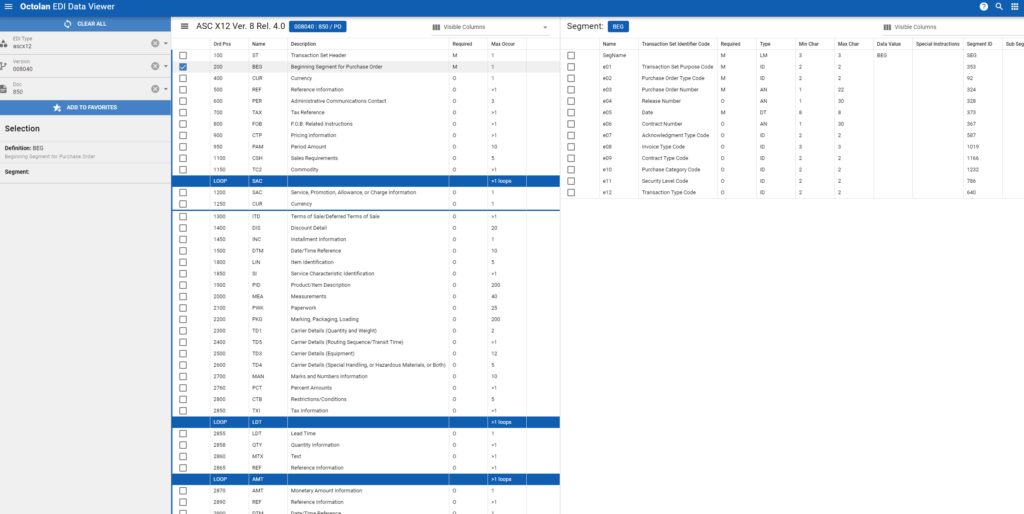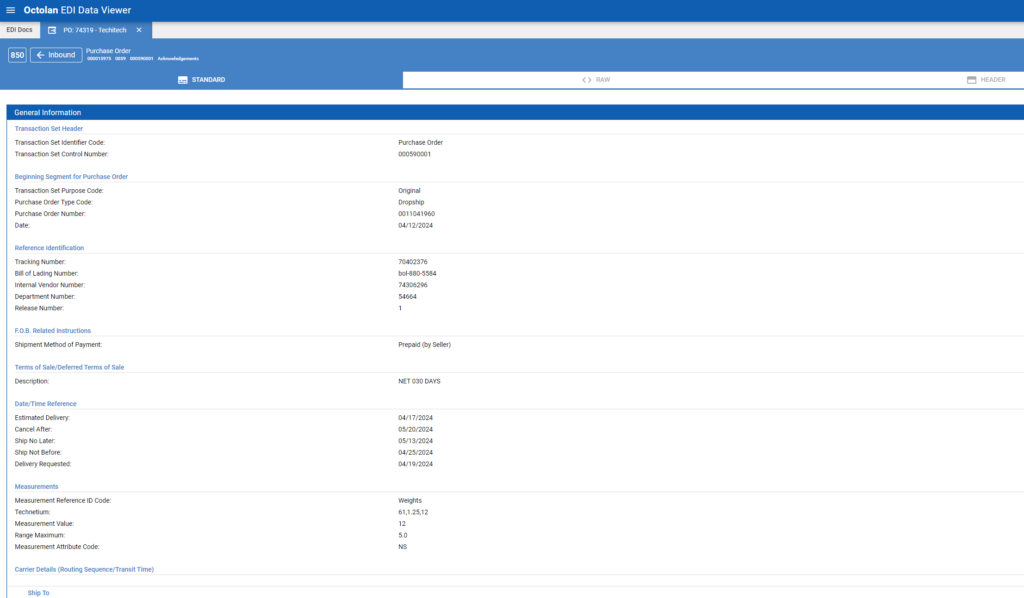EDI 850
Purchase Order
EDI 850 Purchase Order: Understanding the Basics and Benefits
The EDI 850 transaction set is a critical component of Electronic Data Interchange (EDI), which enables businesses to communicate in a standardized format. This particular set serves as the electronic equivalent of a traditional paper purchase order, allowing buyers to specify exactly what goods or services they wish to purchase from a vendor. By converting the purchase order process to an electronic format, businesses achieve greater efficiency, accuracy, and faster processing times, which can improve supply chain operations and reduce errors associated with manual data entry.
As an integral part of EDI, the 850 transaction set streamlines the purchasing process. It includes detailed information, such as the description, quantities, and agreed upon prices of the items being ordered, as well as shipping instructions and payment terms. This standardized approach to generating an electronic purchase order ensures that both the buyer and seller are aligned on the expectations of the transaction. Adopting the EDI 850 can lead to enhanced communication between trading partners and contributes to a more seamless, automated procurement process.
The format for an EDI 850 transaction set aligns with the American National Standards Institute (ANSI) X12 standard, which is widely used in North America and by international businesses engaging with North American companies. The X12 format provides consistency across different industries and EDI transactions, facilitating a universal language for business-to-business communication. As a result, companies that utilize the EDI 850 can engage with a broad network of partners and vendors, without the need for customization for each new business relationship.
Understanding EDI 850 Purchase Orders
Electronic Data Interchange (EDI) 850 documents are crucial as they expedite the purchasing process by replacing traditional methods with efficient, electronic transactions. This document standard fosters clear communication between trading partners.
Structure of an EDI 850 Document
The structure of an EDI 850 document is standardized to ensure consistent communication between trading partners. These documents usually contain a series of segments and elements that detail the specifics of an order. They follow a strict order, beginning with the ST (Transaction Set Header) segment and ending with the SE (Transaction Set Trailer) segment, framing the core content of the purchase order.

Sample Segments of an EDI 850 Document:
- ST Segment: Marks the start of the transaction set.
- BEG Segment: Indicates the beginning of the purchase order transaction and contains important details like order date and purchase order type.
- REF Segment: This is used for reference information. For example, a contract number or agreement might be specified here.
- DTM Segment: Provides the date/time/period segment, offering essential timestamps for the transaction.
- N1 Segment: The Name segment identifies parties involved by their name, providing clarity on the buyer and seller.
- PO1 Segment: This is the baseline item data segment, specifying details about the items or services ordered.
- CTT Segment: The Transaction Totals segment summarizes the number of line items and the total quantity ordered.
Each segment includes various elements that provide specific data related to the segment’s purpose.
Key Segments and Elements
Key segments and their elements in an EDI 850:
- ST (Transaction Set Header):
- ST01: Transaction Set Identifier Code, ‘850’ for purchase orders.
- ST02: Transaction Set Control Number, unique number for identification.
- BEG (Beginning Segment for Purchase Order):
- BEG01: Purpose Code, indicates original or change order.
- BEG02: Order Type Code, specifies the type of order.
- BEG03: Purchase Order Number, the unique number assigned by the buyer.
- REF (Reference Information):
- REF01: Reference Identification Qualifier, dictates the type of reference.
- REF02: Reference Identification, the actual reference number or description.
- DTM (Date/Time Reference):
- DTM01: Date/Time Qualifier, denotes the type of date (e.g., order date).
- DTM02: Date, the actual date in a specified format.
- N1 (Name):
- N1: Entity Identifier Code, identifies the party by a code (e.g., ‘BY’ for the buyer).
- N102: Name, the actual name of the party described in N101.
- PO1 (Baseline Item Data):
- PO101: Assigned Identification, a line item number.
- PO102: Quantity Ordered, specifies the number of units ordered.
- CTT (Transaction Totals):
- CTT01: Number of Line Items, counts the total number of PO1 segments.
- CTT02: Total Quantity, sums the quantities from each PO1 segment.
- SE (Transaction Set Trailer):
- SE01: Number of Included Segments, total number of segments between ST and SE.
- SE02: Transaction Set Control Number, must match the ST02 for validation.

Implementation and Best Practices
The successful implementation of EDI 850 involves careful coordination with trading partners and a strong focus on efficiency, compliance, and security. Organizations should consider these key areas to ensure a seamless integration of the EDI 850 transaction set into their business processes.
Setting Up EDI With Trading Partners
When establishing an EDI 850 connection, both trading partners must agree on specific EDI standards and versions to use, such as ANSI X12. The Interchange Control Header (ISA), Functional Group Header (GS), and their corresponding trailers, Interchange Control Trailer (IEA) and Functional Group Trailer (GE), are critical components that must be correctly set up to ensure accurate and secure data exchange between partners.
- Agreement on EDI Protocols: Determine whether to use a Value-Added Network (VAN) or direct transmission methods such as FTP or AS2.
- Software Integration: Implement EDI software or service that is compatible with existing Enterprise Resource Planning (ERP) systems.
- Test Transactions: Conduct thorough testing with trading partners to ensure all systems are compatible and operational.
Optimizing the Ordering Process
An EDI 850 purchase order streamlines the ordering process, reducing the likelihood of human errors and improving transaction speed. Vendors benefit from quicker order processing and clearer communication regarding order specifics.
- Automation: Utilize EDI 850 to automate purchase order generation and receipt.
- Acknowledgements: Ensure the system is set to send EDI 855 (Purchase Order Acknowledgment) or EDI 997 (Functional Acknowledgment) in response to an EDI 850 to confirm receipt and acceptance.
Maintaining Compliance and Security
Compliance with industry standards and maintaining high levels of security are paramount when implementing EDI 850. Trading partners must adhere to agreed-upon formats and be vigilant in protecting sensitive data transmitted between systems.
- Data Protection: Implement robust security measures, including encryption and secure channels, to protect data integrity and confidentiality.
- Regulatory Compliance: Stay updated on relevant regulations and ensure that the EDI system conforms to industry-specific guidelines and legal requirements.
By considering these factors, organizations can create a robust framework for using EDI 850, leading to improved business relationships and operational efficiency.
Benefits of Using EDI in the Purchase Order Process
The adoption of EDI (Electronic Data Interchange) in the purchase order process presents distinct advantages by fostering an environment of efficiency and precision. These benefits are particularly evident in streamlining operations, curtailing errors, and strengthening the synergy between trading partners.
Streamlining Supply Chain Operations
EDI enables supply chains to streamline transactional order to cash and purchase to pay processes through the digital exchange of purchase orders and related documents. This electronic format allows for rapid communication between buyers and suppliers, resulting in a more efficient supply chain. By automating purchase order transactions, companies can quickly move goods and manage inventory, leading to enhanced operational workflows and reduced order processing times.
Reducing Errors and Improving Accuracy
Manual entry of purchase order data is prone to human error, which EDI transactions substantially reduce. With predefined formats and standards, EDI systems ensure that critical information such as product numbers, prices, and quantities are transmitted accurately. This precision improves the accuracy of orders and financial transactions, leading to fewer disputes and returns as well as increased trust between trading partners.
Enhancing Trading Partner Relationships
EDI contributes to stronger relationships with trading partners by enabling consistent and predictable transaction exchanges through EDI solutions. Both buyers and sellers benefit from the reliability of EDI systems that facilitate on-time deliveries, compliance with contractual conditions, and transparency. As vendors and customers engage in a more streamlined and error-free process, the professional relationship solidifies, creating a conducive atmosphere for ongoing and future business opportunities.
Frequently Asked Questions
In the context of EDI (Electronic Data Interchange), the 850 transaction set, a key edi 850 specification, is crucial for electronic purchase orders. It standardizes the exchange of order information between trading partners, ensuring accuracy and efficiency.
What does an EDI 850 transaction set represent?
It represents an electronic document used by buyers to communicate to suppliers the specific items, quantities, and agreed prices for products or services.
How can an EDI 850 be used in the purchase order process?
An EDI 850 can streamline the purchase order process by electronically sending detailed order information to suppliers. It initiates the order fulfillment cycle with standardized data exchange.
What is the structure of an EDI 850 document?
The EDI 850 document is structured with segments and data elements that conform to a specific format and sequence to detail the purchase order information, such as buyer and seller IDs, terms of sale, and item descriptions.
Can you provide an example of an EDI 850 message format?
An example format of an EDI 850 message includes a header segment indicating the start of the transaction set, followed by segments including purchase order number, terms of delivery, and item-level information.
How is the EDI 850 integrated within an SAP system?
Within an SAP system, the EDI 850 can be integrated through the IDoc interface, which converts the EDI format into an applicable format for SAP to process the purchase order transaction.
What are the key components of an EDI 850 Implementation Guide?
An EDI 850 Implementation Guide provides the necessary specifications for correctly formatting the transaction set, including segment and element details, and the sequence and usage of each to ensure compliance with industry standards.
What is the difference between EDI 850 and 855?
The fundamental difference between EDI 850 and EDI 855 lies in their purpose within the procurement process. EDI 850 is a Purchase Order document, signaling the buyer’s intention to purchase goods or services. It contains details like prices, descriptions, and quantities. Conversely, EDI 855 is a Purchase Order Acknowledgment, which suppliers use to confirm receipt of an EDI 850. The EDI 855 might also indicate any adjustments or inability to fulfill some or all the items ordered, making these documents essential for the smooth operation of supply chain communications.
What is the difference between EDI 875 and 850?
The primary difference between EDI 875 and EDI 850 lies in their application contexts. While EDI 850 is a Purchase Order used across various industries to order goods or services, EDI 875 is a Grocery Products Purchase Order specifically designed for the grocery sector. This specialization makes EDI 875 tailored for grocery-related transactions, enhancing efficiency and relevancy.
What is the difference between 810 and 850 EDI?
The key difference between 810 EDI and 850 EDI lies in their purpose. The 810 EDI transaction set is used for electronic invoices, facilitating the billing process between vendors and buyers. On the other hand, the 850 EDI serves as a Purchase Order, allowing buyers to electronically send order information to suppliers.
What is the difference between EDI 855 and 856?
The EDI 855 is a Purchase Order Acknowledgment, used by suppliers to confirm the receipt and acceptance of a purchase order from a buyer. The EDI 856, on the other hand, is an Advance Ship Notice, which provides detailed information about the shipment of goods to the buyer, including carrier information and expected delivery date.
